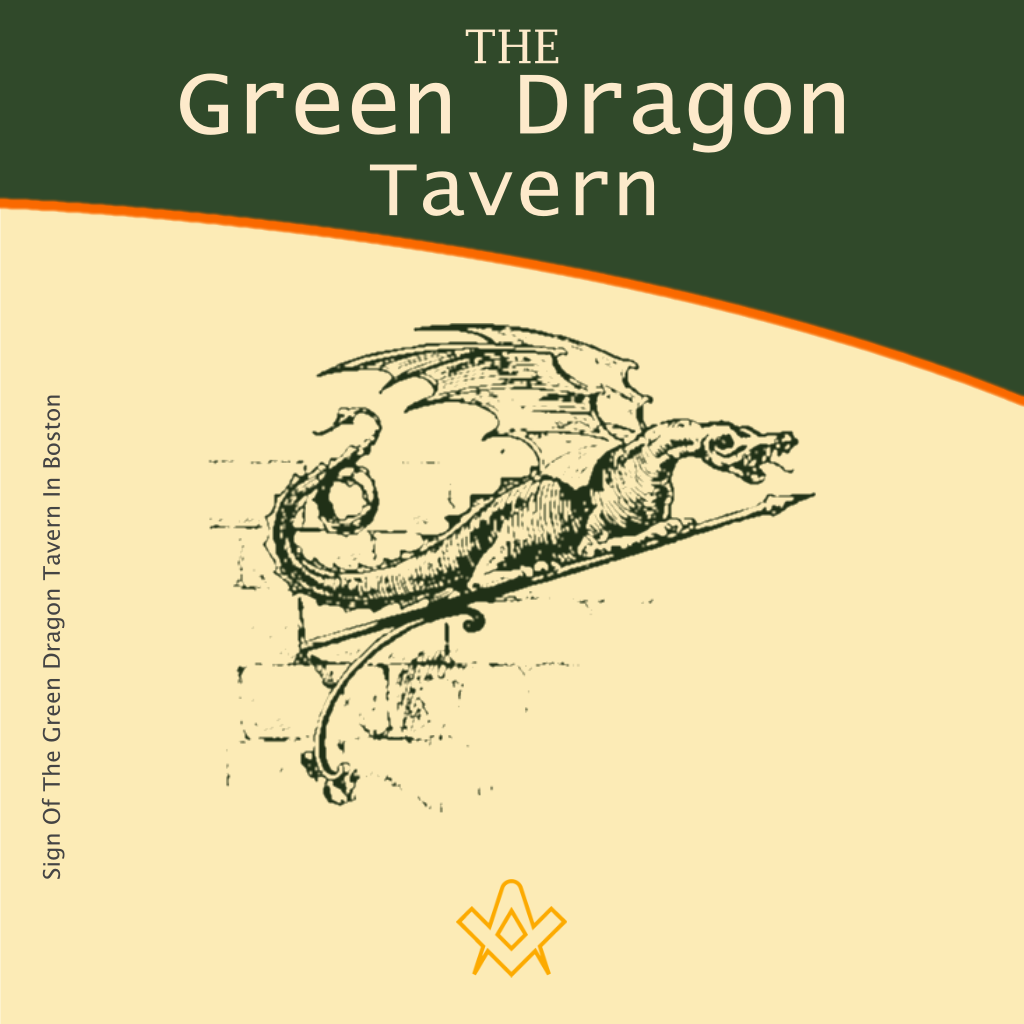The Green Dragon Tavern, or Freemasons’ Arms
By: Bro. CHARLES W. MOORE, Massachusetts
From The Builder, August 1923
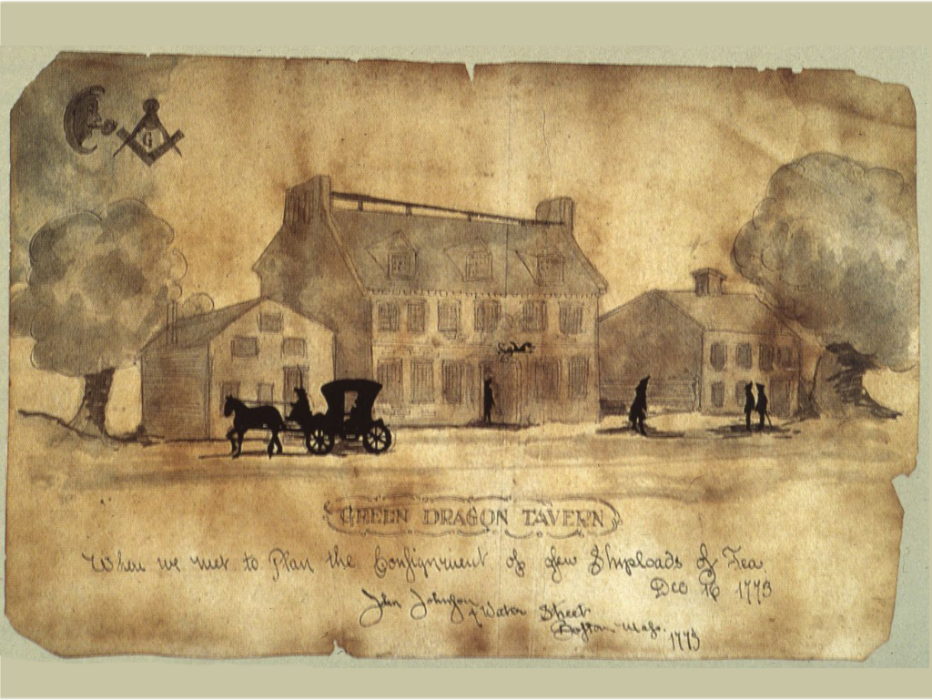
“Where we met to Plan the Consignment of a few Shiploads of Tea, Dec 16, 1773”
John Johnston (c. 1753-1818) watercolor sketch, n.d. Original at American Antiquarian Society, 185 Salisbury St, Worcester, MA 01609-1634. Image via: The Grand Lodge of British Columbia and Yukon A.F. & A.M.
IMAGE LINKED: https://freemasonry.bcy.ca/history/boston_tea_party.html
What the Goose and Gridiron Tavern is in the ancient annals of London Freemasonry, the Green Dragon Tavern is to the memories of the Free-mason, of Boston and New England.
In it and about it revolved many of the most exciting activities of the Boston Revolutionary times, not the least of which were the patriotic caucuses and plotting of the brethren who in those days held their lodge in that historic building.
But there is no need here to expatiate upon that subject: the whole story is told at length and in colorful detail in the article printed below, which is an extract beginning on page 155 of “The Lodge of St. Andrew, and the Massachusetts Grand Lodge,” printed in Boston, 1870, “by vote of the Lodge of St. Andrew.”
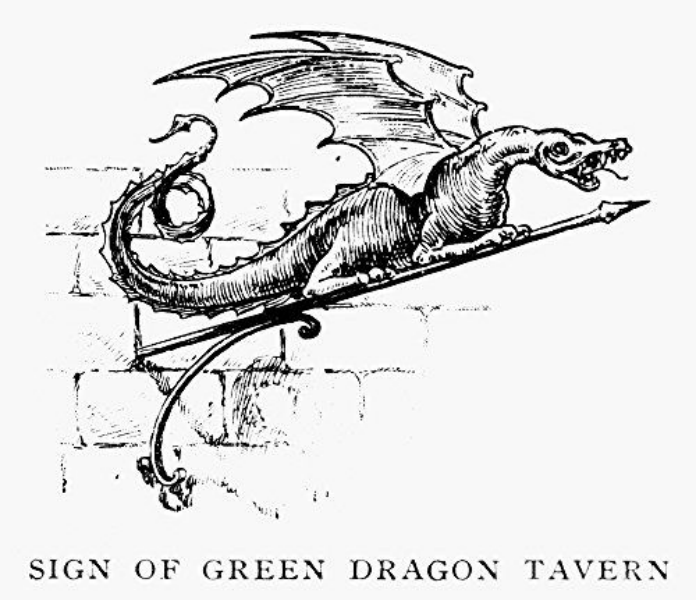
“The Green Dragon sign from ‘Old Boston taverns and tavern clubs’
Noted Landmarks, which call to mind associations with the early history of a nation, always possess a peculiar interest to all lovers of their country, and the story belonging to them is awakening, as well as instructive.
Among the famous places of Boston, in past days, was a widely known and celebrated building called the Green Dragon Tavern, situated on the border of a mill pond, in what is now Union Street, and near the corner of Hanover Street; “in its day,” it was the best hostelry, of the town.
The celebrity of the “Green Dragon” however, is not now due to any remembered excellence of hospitable entertainment, but for the social and political public and private gatherings of the people, – with other interesting local incident, – for three fourths of a century, antecedent to the American Revolution; and above all, for the stirring, patriotic, no less than timely consequential measures determined under its roof by the historic men of ‘76, who brought to pass that memorable Epoch.
It was indeed the cradle of “Rebellion”; the chosen asylum, where the Revolutionary master spirits, – who organized successful resistance to British aggression on the liberties of the colonies, – took grave counsel together.
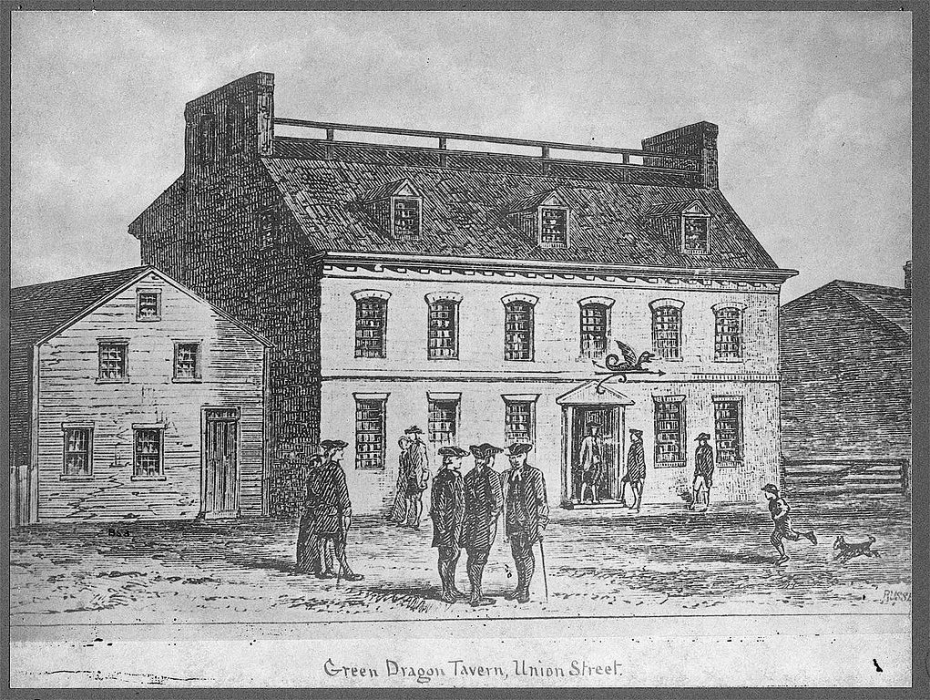
Green Dragon Tavern, Union Street. Engraver: Russell. 1898 (approximate). Copy photograph from engraving by Russell of the tavern in the North End where the Sons of Liberty planned the Boston Tea Party.
IMAGE LINKED: wikimedia Attribution 4.0 International (CC BY 4.0)
To the Masonic Fraternity of Massachusetts, the old “Green Dragon,” – which, a century ago, began to be called also “Freemasons’ Arms,”– presents associations of especial significance.
It was here within its walls, that the Freemasonry of this commonwealth was preserved in Grand Lodge jurisdiction, bright and vigorous; where its charities, its hospitalities, and its good tidings were kept up between the years 1775 and 1792, a period which witnessed the disruption, by reason of the war for Independence, of important branches of the Order in Massachusetts.
Still further, this was the scene of [Joseph] Warren’s most intimate political and Masonic associations, with the patriots and Masons of his time.
To the members of the Lodge of St. Andrew, this estate, – their own magnificent possession for more than a hundred years, – is endeared by ties which run over a still longer period.
No picture of the Green Dragon Tavern of any description, is known to be in existence save the one now presented in this “Memorial.” This was engraved recently for the Lodge of St. Andrew, from a model which the Hon. N.B. Shurtleff prepared some years since, with his usual accurate and thorough knowledge of ancient, noted Boston houses.
From this model in wood, with much painstaking on the part of the “Lodge,” in the way of exhibiting it for criticism to old inhabitants who were familiar with the look and details of this ancient structure – which was removed forty-two years ago, – the present picture has been made.
It is believed to be a faithful representation and it may also be affirmed that it is unanimously recognized as such by everyone who is competent to judge.
FROM THE RECORDS OF THE LODGE
At a Quarterly Communication, March 24, 1864, the Worshipful Master, Edward Stearns, called the attention of the Lodge to the fact that the Green Dragon Tavern was purchased by this Lodge, March 31, 1764, and that Thursday next, the 31st instant, would complete a period of one hundred years from the date of the deed of that estate.
Whereupon, on motion of Brother Wellington, it was Voted, that a committee of five be appointed, with full power to make arrangements for celebrating the Centennial Anniversary of the purchase of the Green Dragon Tavern.
The following brethren were appointed: A. A. Wellington, Charles W. Moore, J.R. Bradford, Samuel P. Oliver, and Isaac Cary.
On motion of Brother Palmer, it was Voted, That the above committee be increased to eight, that being the number of the original committee appointed January 12, 1764, “to purchase a house for the benefit of the Lodge of St. Andrew.”
The Worshipful Master, Brother Wm. F. Davis, Senior Warden, and Brother John P. Ober, were thereupon added to the committee.
THE FOLLOWING IS THE LODGE RECORD OF THE CELEBRATION
A special meeting of the Lodge of St. Andrew was held in the new building on the “Green Dragon” estate, Union Street, on Thursday evening, March 31, 1864, at 6 ½ o’clock, for the purpose of celebrating the Centennial Anniversary of the purchase of the Green Dragon Tavern.
An apartment in the building was suitably decorated for the festival, and a bountiful dinner provided.
The Worshipful Master presided, and in a dignified, appropriate address, invoked the attention of the brethren to the ceremonies of the evening, and to the remarks of members whom he should call upon to speak upon the pleasant Masonic memories suggested by the spot whereon the Lodge was then assembled, and to the historical incidents connected with the “ancient Inn.”
After a proper allusion to the distinguished men who had held Masonic intercourse together in times past in the hall of the “Green Dragon,” the Worshipful Master called up M.W.Brother Wm. Parkman:
Who stated that on the 12th day of January, 1764, the Lodge resolved by vote to purchase a house; accordingly Thomas Milliken, Samuel Barrett, Edward Foster, Caleb Hopkins, Moses Deshon, William Haskins, Joseph Webb, and John Jenkins were chosen a committee for that purpose.
On the succeeding 31st of March, Catherine Kerr, by her deed of that date, conveyed in fee the premises known as the Green Dragon Tavern, unto the above-named committee.
The estate was managed by committees of the Lodge until 1832, when the estate was conveyed to Brothers Benjamin Smith, Henry Purkett, Zephaniah Sampson, David Parker, Thomas W. Phillips, John Suter, and Ezekiel Bates, to be held by them as trustees for the use and benefit of the Lodge of St. Andrew.
In January 1852, Brothers Smith, Purkett, and Suter being deceased, a new board of trustees, consisting of Brothers David Parker, E. Bates, T. W. Phillips, Z. Sampson, J.P. Ober, Thomas Resteaux, and Wm. Parkman were chosen, to whom the premises were conveyed for the use and benefit of the Lodge.
Brother David Parker was chosen chairman, Brother T. W. Phillips, treasurer, and Brother Wm. Parkman, secretary.
In 1855, Brother Parker having removed from the city, resigned as chairman, and Brother John P. Ober was elected to fill the vacancy.
In 1859, Brother Phillips died, and Brother Restieaux was elected treasurer.
The Most Worshipful Winslow Lewis then addressed the lodge, and said that:
By the dispensation of the Supreme Grand Master, a severe domestic affliction has deprived us all of the presence of Brother Charles W. Moore, from whom we should have received the fullest information of those memorials of the past, which are so hallowed to the memories of every member of the Lodge of St. Andrew, who are now assembled to commemorate, on this spot, the associations connected with a locality dear to every Masonic heart, to every patriot’s breast!
But, Worshipful Master, our Brother Moore, though absent, and stricken by bereavement, was not willing to let this Centennial occasion pass by, without communicating such interesting facts relating to the Green Dragon Tavern as he had from time to time preserved.
And I therefore shall, with your permission sir, read a communication on this subject, which my Brother Moore has handed me, to be presented to the Lodge at this festival.
REMINISCENCES OF THE GREEN DRAGON TAVERN
With perhaps the single exception of Faneuil Hall, there was no public building in Boston at the close of the last century, which had acquired a more extensive notoriety or filled a larger place in the local history of the town, than the old “Green Dragon Tavern.”
I need not trouble you with any particular description of it, for that will be given by one who is pre-eminently distinguished for his extensive and accurate knowledge of all the interesting historical localities of the city.
We have no record or other authentic evidence of the fact, but there can be little doubt that St. Andrew’s Lodge, which was, in its incipiency, composed largely of North-End men, originated and was informally organized in the “Long Room,” so-called, in the northerly end of this Tavern, in the year 1752.
It is nevertheless proper to say, that this inference is predicated on the known fact, that it was in this Hall that in 1756 it was re-organized and commenced work under a Charter from the Grand Lodge of Scotland, – a circumstance that would not have probably occurred, had not the Hall been previously occupied by it, and was then in a condition suited to its purposes.
And this hypothesis is strengthened by the additional fact, that it continued to hold its regular monthly meetings here until the year 1818, when it was removed to the Exchange Coffee House.
It was in this “Long Room,” also, where so much of our Revolutionary history was made, that the Massachusetts Grand Lodge – an offshoot of St. Andrew’s Lodge – with Joseph Warren for its Grand Master, was organized on the 27th of December, 1769, and continued to hold its meetings until its union with the St. John’s Grand lodge in 1792.
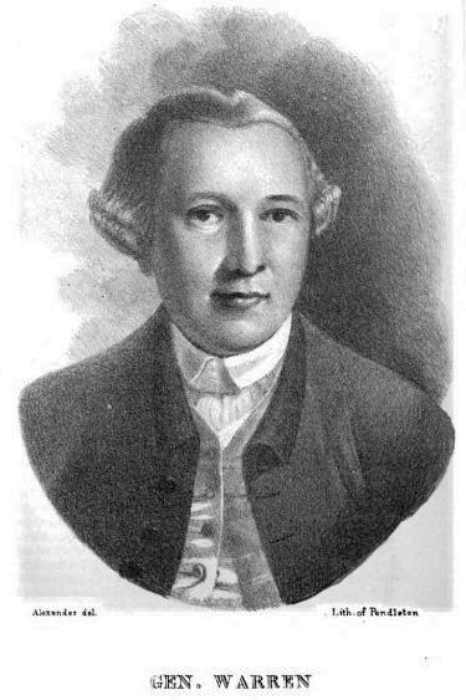
Portrait of Joseph Warren, Boston Monthly Magazine, 1826.
IMAGE LINKED: wikimedia Attribution 4.0 International (CC BY 4.0)
In 1697, the tavern was kept by John Cary, and was at that early day, and perhaps earlier, known as the Green Dragon Tavern.
In 1764, the property was purchased by St. Andrew’s Lodge, when it took the name of “Freemasons’ Arms,” – the new proprietors having placed a large Square and Compass on the front of the building.
It however soon after dropped this title and was more popularly known as “Masons’ Hall”; by which name it continued to be masonically designated until the removal of the Lodge, when it resumed its ancient title of “Green Dragon Tavern.”
On the 24th of June, 1772, the festival of St. John the Baptist, was celebrated by the Massachusetts Grand Lodge, by a public procession, formed at Concert Hall, the brethren marching in full regalia to Christ Church in Salem street, where “a very suitable and pertinent discourse was preached by the Rev. Samuel Fayerweather, of Narragansett”; after which they returned to Masons’ Hall, and “dined together in the Garden, under a long Tent erected for that purpose; and the remainder of the day was dedicated to mirth and social festivity.”
The garden here spoken of, was in the rear of the house, and extended northerly to the water, covering the ground now occupied by Mr. Riddle as a salesroom.
Our late Brother Sampson has said to me that he was accustomed in his boyhood days, to fish for flounders at the lower end of this garden, which, in early times, extended to what was then known as the “Mill Pond” – a large basin of salt water, cut off from Charles River by dykes, and used for mill and other purposes.
It was here that in the wintertime the “North-End Boys” and the “West Enders” used to fight their mimic, and not always bloodless, sectional battles, until, after the occurrence of several serious mishaps, they were interfered with, and their sports forbidden by the Selectmen of the town.
It is hardly necessary to say that the area formerly occupied by this pond is now an extensive business section of the city.
There were present at the above celebration, M.W. Joseph Warren, Grand Master; R. W. Joseph Webb, D.G.M.; Paul Revere, S.G.W., pro tem; Thomas Crafts, J.G.W. pro tem.; Samuel Barrett, G. Treasurer; Wm. Palfrey, G. Secretary; and the Masters, Wardens, and brethren of St. Andrew’s Tyrian, Massachusetts, and St. Peter’s Lodges, together with a sufficient number of visitors to make a company of ninety-seven brethren, which at that early day was a very large and full attendance.
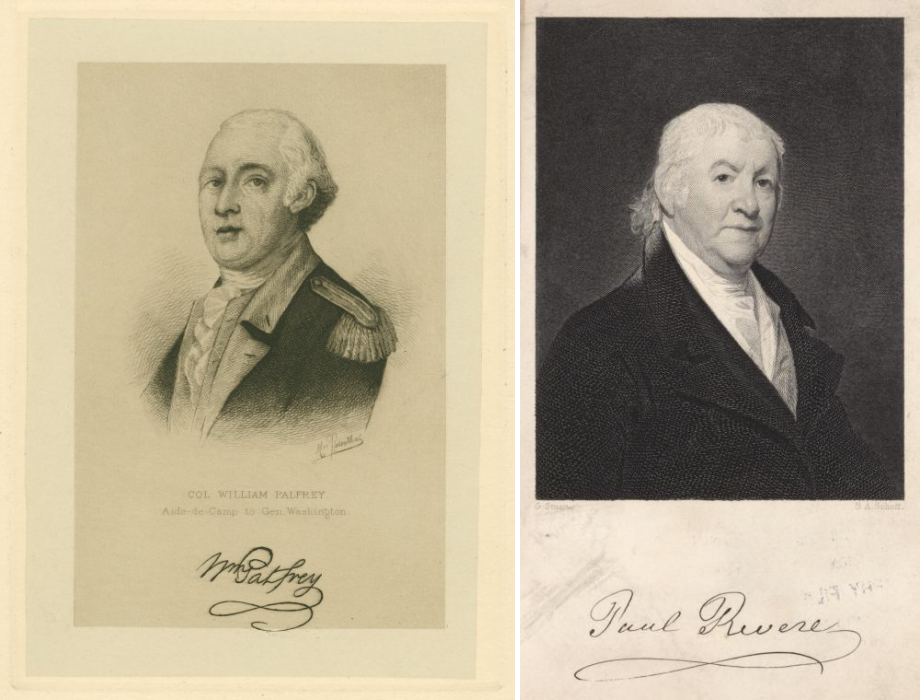
left: “Col. William Palfrey.” The New York Public Library Digital Collections.
Right:”Paul Revere.” New York Public Library Digital Collections. Accessed March 18, 2022.
IMAGE LINKED: digitalcollections.nypl.org Attribution 4.0 International (CC BY 4.0)

Registration of Lodge Membership for Paul Revere, Joseph Warren and William Palfrey, held by the Grand Lodge of Free and Accepted Masons of Scotland (The Grand Lodge of Scotland). – By Ericthearcher – Own work
IMAGE LINKED: wikimedia Attribution 4.0 International (CC BY 4.0)
Two Grand Lodges, and the Royal Arch
Our brethren, in these early days of the Institution in the colonies, were more particular in the observance of the winter and summer festivals of the Order (Dec. 27th and June 24th) than their successors have been.
These celebrations, however, were not always public. On the contrary, I believe that of the 24th of June, 1772, was an exceptional case in the history of the Massachusetts Grand Lodge; and, consequently, in that of our own Lodge; for the two bodies, on all occasions, moved as a unit, and held their festivals together at the Green Dragon.
I will not occupy your time by referring to them in the order in which they took place, but that of 1773, being the last with which General Warren’s name is connected as being present, I deem it worthy of special notice in this connection; and this cannot be done more satisfactory than in the words of the record. The annual communication of the Grand Lodge was held this year, on the 3rd of December, and after the ordinary business had been disposed of, the record says:
“The Most Worshipful Grand Master (Warren) then desired the opinion of the Grand Officers present, with respect to Celebrating the Feast of St. John the Evangelist, 27th Instant.
“Motioned and Seconded, The Feast be Celebrated the 27th Instant, at Masons’ Hall (at the Green Dragon).
“Voted, The Stewards of the Grand Lodge of St. Andrew’s, and the Massachusetts Lodges, agree for and provide the dinner, and that three Brethren be desired to joyn the Stewards.
“Voted, Brothers Bruce, Proctor [and] Love.
“Voted, The Festival be advertised in the Public Prints.”
I accordingly find in the “Boston Evening Post,” of December 20, 1773, the following advertisement:
“THE Brethren of the Honourable Society of Free and Accepted MASONS, are hereby notified, That the Most Worshipful JOSEPH WARREN, Esq., Grand Master of the Continent of America; intends to Celebrate the Feast of St. JOHN the Evangelist, on Monday the 27th of December Inst. at Free Masons’ Hall (at the Green Dragon), Boston, where the Brethren are requested to attend the Festival.
By Order of the Most Worshipful Grand Master.
Wm. Hoskiss, G. Sec’y.
“N.B. Tickets may be had of Mess. Nathaniel Coffin, junr., William Mollineaux, junr., and Mr. Daniel Bell.
“The Table will be furnished at Two o’clock.”
This “Feast” was held in the Long Room of the Green Dragon on the 27th, and the record names as being present, “M.W. Joseph Warren, Esq., Grand Master; Hon. Wm. Brattle, Esq.; Rev. Dr. Samuel Mather; Worshipful Joseph Webb, Esq.; and thirty-eight others including the Grand Officers.”
There had formerly been some degree of coldness between the two Grand Lodges in the Province; as was natural enough in view of the causes which led to the organization of the younger body.
It is therefore the more gratifying to find on the record such unmistakable evidence of the fraternal feeling existing between them at this time, as the following:
“The Most Worshipful Grand Master was pleased to direct three Brethren, viz: Jona. Williams, Elisha Thatcher, and H. Hatell, to wait upon The Most Worshipful John Rowe, Esq., Gd. Master, the Grand Officers and Brethren at Their Feast, at Col. Ingersoll (Bunch of Graves Tavern), to acquaint them, the Healths would be drank at half after 4 o’clock.
The committee returned for answer, that Grand Master Rowe and the Brethren concerned would return the Compliment at that period.”
It was in the “Long Room” of the Green Dragon that on the 28th of August, 1769, the present St. Andrew’s Chapter was organized as a Royal Arch Lodge, under the authority of the Charter of St. Andrew’s Lodge.
This degree was anciently given in Masters’ Lodges, which arrangement was subsequently changed, and it was conferred in Royal Arch Lodges, attached to and working under the authority of the Charters of Craft lodges.
The present Constitutions of the Grand Lodge of Ireland still retain a nearly analogous provision in the following words:
“Every Warrant to hold Councils or Encampments, shall be granted to some warranted or acknowledged Lodge to which a Royal Arch Chapter is attached; and shall not only bear the same number, but shall be held in the same place in which the Lodge and Chapter usually hold their meetings.”
General Warren was a member of this Lodge, and being present in 1770, the year after its organization, the record says he
“gave his opinion in favour of holding (continuing) the Royal Arch Lodge until he should receive instructions from Scotland. If then so directed, he will grant them a Charter therefor.”
There is no evidence that such a charter was required or issued, and the Lodge continued to hold its meetings at the same place, and under its original authority, until the 25th of November, 1790, at which date we find in the records the following vote:
Voted, That Brother Matthew Groves be a committee to return the thanks of this Lodge to St. Andrew’s Lodge for their politeness in granting us the use of their Charter.
General Warren, as before stated, was a member of the Royal Arch Lodge, as were also Col. Joseph Webb, Col. Paul Revere, and other prominent members of St. Andrew’s Lodge.
Indeed, of the twenty-one members who composed the Royal Arch Lodge in 1769, fourteen of them were members of St. Andrew’s Lodge.
In 1794 this Lodge assumed the name of a “Royal Arch Chapter,” and in 1798 it united with King Cyrus Chapter of Newburyport, and at Masons’ Hall, in the “Green Dragon Tavern,” organized the Grand Royal Arch Chapter of Massachusetts.
On the 17th of May, 1770, the petitioners for “the Massachusetts Lodge,” which was a scion of St. Andrew’s Lodge, met at “Masons’ Arms,” in the “Green Dragon Tavern,” and organized that body.
It held its second meeting at the same place on the following 4th of June, and was then removed to “Concert Hall.”
And on the 10th of November, 1795, Columbian Lodge also held a meeting at the “Green Dragon.” These were the only occasions when the “Long Room” was ever occupied by any other private Masonic Lodge than our own.
Columbian Lodge was at this date located at Concert Hall, and its occupancy of the room on the occasion referred to, was probably a matter of accommodation to the proprietors of that establishment, which was then the popular resort for dancing parties and other social purposes.
The ‘North-End Caucus’, Sons of Liberty, and the Boston Tea Party
But it is perhaps to the political associations which cluster around its name, that the Green Dragon Tavern is more particularly indebted for its historic celebrity.
It was here that many of the most important and eventful of the political transactions preceding the Revolution were, if not positively inaugurated, discussed, matured, and put into execution.
That this was so, is undoubtedly in some measure to be accounted for by the fact, that the Hall in the building was the only room in the Northern section of the town, excepting Deblois’s Hall, on the corner of Queen and Hanover streets, which at that time was adapted to popular assemblies; and by the additional and perhaps more significant fact, that the principal leaders of the Revolution in Boston, were members of the Masonic Fraternity, and many of them of the Lodge which held its communications there, – a circumstance which would very naturally influence them in the selection of the place for their private consultations.
It is not however, to be inferred from this, that they either met as Masons or used Masonry as a cover to their purposes; for others than Masons were associated with them.
But be this as it may, it will not be irrelevant nor perhaps wholly uninteresting to the members of the lodge, to refer briefly to some of the more popular purposes to which the Hall, in the early days of its history, was appropriated.
One of the largest, and perhaps one of the most efficient of the political clubs which sprung into existence during the troublous times of 1768, and onward, was that known as “The North-End Caucus.”[aka the Boston Caucus]
This body was composed almost exclusively of North-End mechanics, – distinguished for their daring and activity, – and held its meetings in the Hall of the “Green Dragon Tavern.”
Warren who, Frothingham says, was idolized by the North-Enders,” was an influential member of it, as were Revere and others of his personal friends.
The Hall was also used as a central and safe place for the meetings of private committees and rallying clubs, with which Warren, as chairman of the “Committee of Safety,” was in frequent consultation, and directed their movements. Barry, in his History of Massachusetts, says:
“The town (Boston) was full of clubs and caucuses, which were used with effect to secure unity of action; and the hardy mechanics who had done so much to promote the industrial prosperity of the metropolis, and who now acted as patrols, were the steady supporters of the patriot cause.
In vain were the artifices of loyalists employed to seduce them to compliance with the wishes of his excellency; and when their services were required at the barracks, ‘all the carpenters of the town and country’ left off work; and British gold was powerless to tempt them, though ‘hundreds were ruined, and thousands were half starved,’ nay, they went further, and obstructed the works of the governor.
His supplies of straw were set on fire; his boats conveying bricks were sunk; and his wagons laden with timbers were overturned.”
The character and services of these important Clubs are well illustrated by our Brother Paul Revere, in his narrative of the events of 1775, when he says, about thirty persons, chiefly North-End mechanics, had agreed to watch the movements of the British soldiers and the Tories, in anticipation of their descent on Concord.
These patriots met at the Green Dragon Tavern. “We were so careful,” he says, “that our meetings should be kept secret, that every time we met, every person swore upon the Bible that they (he) would not discover any of our transactions, but to Messrs.
Hancock, Drs. Warren and Church, and one or two more leaders. They took turns to watch the soldiers, two by two, by patrolling the streets all night.”
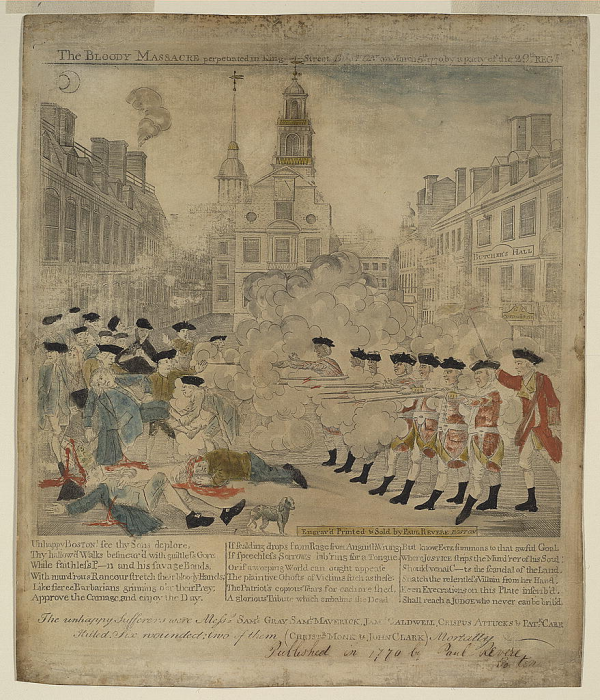
The bloody massacre perpetrated in King Street Boston on March 5th 1770 by a party of the 29th Regt. Engraving by Paul Revere. Library of Congress Prints and Photographs Division
IMAGE LINKED: loc.gov Attribution 4.0 International (CC BY 4.0)
In reference to this club, Elliott, in his history of New England, has the following: “Among the most active of the Sons of Liberty was Paul Revere.
In the Fall and Winter of 1774-5, some of the best Boston mechanics formed themselves into a club, to watch the doings of the British soldiers.
They were ‘High Sons of Liberty,’ and men of action, who met at the Green Dragon Tavern; and every man swore on the Bible that nothing should be revealed except to Samuel Adams, John Hancock, Dr. Warren, and Dr. Church” (the latter a traitor).
Revere was a leading man in this club and was sent by Warren on the night of the 18th of April to notify Hancock and Adams of the movement of the British troops on Lexington and Concord, at the former of which places these two patriots were concealed.
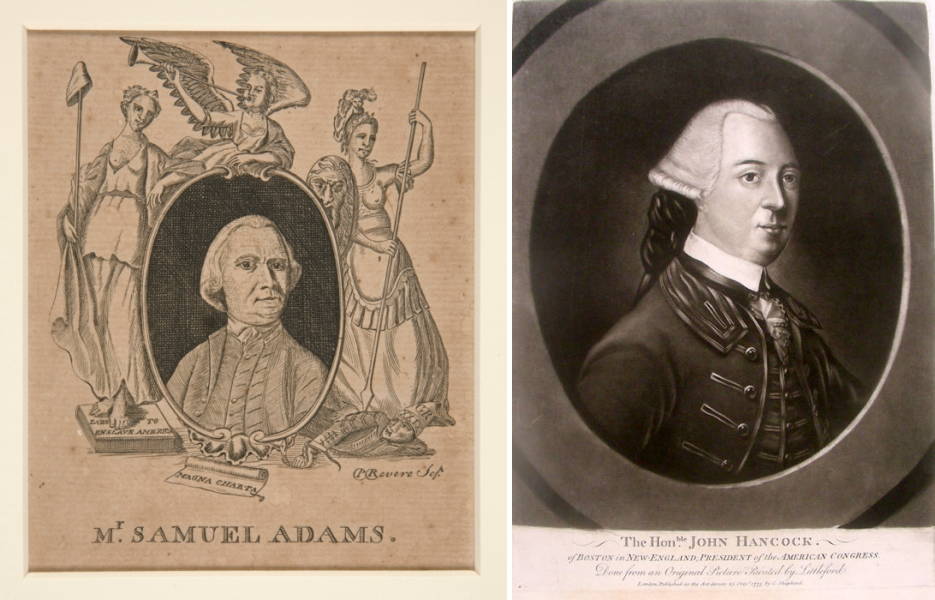
left: Mr. Samuel Adams,” by Paul Revere, 1774. Yale University Art Gallery By Paul Revere – Yale University Art Gallery [1],
right: John Hancock, Attributed to R. Purcell, working under the pseudonym C. Corbutt. Public Domain
IMAGE LINKED: wikimedia Attribution 4.0 International (CC BY 4.0)
Another of these Clubs which held their meetings at the Green Dragon Tavern, was the “Caucus-Pro Bono Publico,” of which Warren was the leading spirit, and in which, says Elliott, “the plans of the Sons of Liberty were matured.”
It is to be regretted that no authentic record of the names of the persons who composed the Boston Tea Party in 1774, has come down to us.
“But,” says Frothingham, “as Warren was presented to the Privy Council as one of the prominent actors in these proceedings, and was held up by his political opponents at home, as one of the Mohawks,” and as “he was not one to shrink from any post of duty, it is not more improbable that he was one of the band who threw the tea overboard, than that his friend John Hancock (captain of the Cadets) should have been one of the guard to protect the actors.”
The tradition of the Lodge is, that all the preliminary measures in this affair were matured at the Green Dragon, and that the execution of them was committed mainly to the members of the North-End Caucus, – that stalwart and fearless band of North-End mechanics, whose directing genius was Warren, having the cooperation of the more daring of the “Sons of Liberty.”
That Warren was present as a leader in the affair, does not admit of any serious doubt; nor is there any question that his personal friends Samuel Adams, John Hancock, Joseph Webb, Paul Revere, Thomas Melville, Adam Collson, Henry Purkett (who used modestly to say he was present only as a spectator, and in disobedience to the orders of his Master, who was actively present), and other patriots of the day, were cognizant of it, – and some of whom at least are known to have participated in its final consummation.
It was the first act in the great drama, the conclusion of which was the independence of the country.
The “Master” referred to above, with whom our late Brother Purkett served his apprenticeship, was Samuel Peck, a cooper by trade, and one of the leading and influential members of the “North-End Caucus.”
He was also an active member of St. Andrew’s Lodge, – a connection which strengthens the tradition of the Lodge, that the table for the famous Tea Party was first spread in its “Long Room.”
Among the members of the Lodge, who are known to have taken an active part in the affair, were Adam Collson, Thomas Chase, Samuel Gore, Daniel Ingollson, Samuel Peck, Edward Proctor, Henry Purkitt, and Thomas Urann.
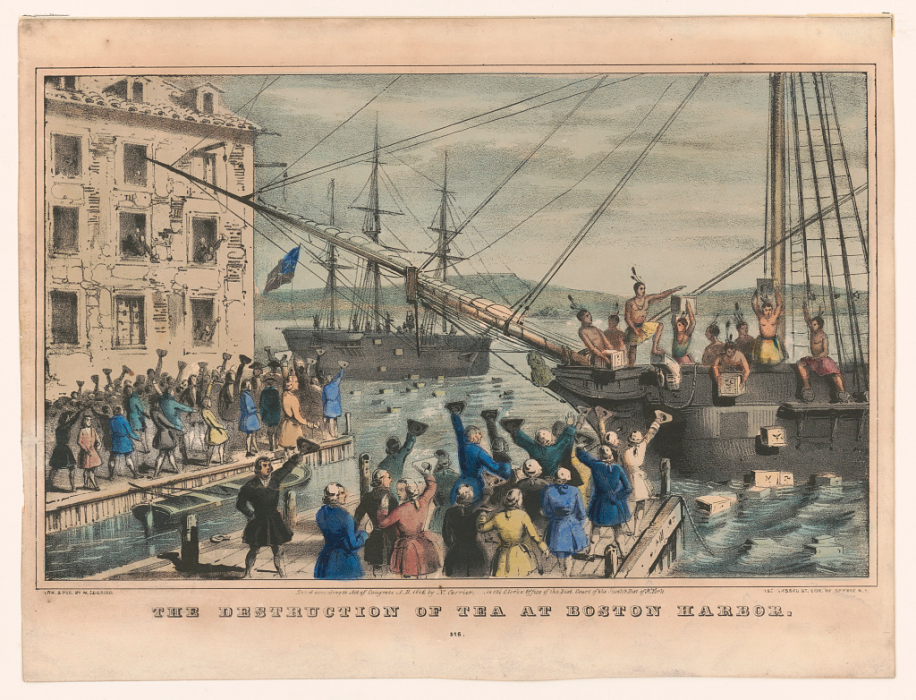
Destruction of tea at Boston Harbor. [New York] : N. Currier, 1846. Library of Congress Prints and Photographs Division
IMAGE LINKED: wikimedia Attribution 4.0 International (CC BY 4.0)
I have looked in vain for a copy of an old revolutionary song said to have been written and sung as a “rallying song” by the “tea party” at the Green Dragon.
The following fragment, though probably not in all respects an exact transcript of the original, will indicate its general character:
Rally, Mohawks! – bring out your axes!
And tell King George we’ll pay no taxes
On his Foreign tea!
His threats are vain – and vain to think
To force our girls and wives to drink
His ‘vile Bohea!
Then rally boys, and hasten on
To meet our Chiefs at the Green Dragon.
Our Warren’s there, and bold Revere,
With hands to do and words to cheer
For Liberty and Laws!
Our country’s “Braves” and firm defenders,
Shall neer be left by true North-Enders,
Fighting Freedom’s cause!
Then rally boys, and hasten on
To meet our Chiefs at the Green Dragon.
I regret not being able to give the balance of this song, but perhaps some curious antiquary may hereafter discover it, if it ever appeared in print.
I am inclined to think, however, that it was a doggerel made for the occasion, and passed away when it ceased to be of use, or appropriate.
The two stanzas I have reproduced, are given as nearly as my memory serves, as they were often recited more than a third of a century ago, by the late Brother Benjamin Gleason, who, born near the time, was curious in gathering up interesting reminiscences of the revolutionary period of our history.
More Intolerable Acts
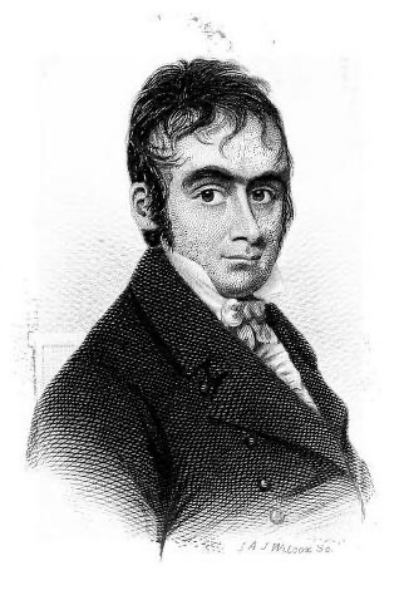
Daniel Webster, frontispiece of The great speeches and orations of Daniel Webster, Little, Brown, & Co., Boston, 1879.
IMAGE LINKED: wikimedia Attribution 4.0 International (CC BY 4.0)
In January 1788, a meeting of the mechanics and artisans of Boston was held at the Green Dragon Tavern, and there passed a series of resolutions urging the importance of adopting the Federal Constitution, then pending before a Convention of delegates from different parts of the State. Hon. Daniel Webster, in a speech delivered by him at Andover, in the autumn of 1843, referring to this meeting and these resolutions, holds the following language:
“There was a particular set of resolutions, founded on this very idea of favouring home productions, full of energy and decision, passed by the mechanics of Boston.
And where did the mechanics of Boston meet to pass them? Full of the influence of these feelings, they congregated at the Head-Quarters of the Revolution.
I see, waving among the banners before me, that of the old Green Dragon.
It was there, in Union Street, that John Gray, Paul Revere,” – both members of the Lodge, “and others of their class, met for consultation.
There, with earnestness and enthusiasm, they passed their resolutions. A committee carried them to the Boston delegation in the Convention,” then in session.
Paul Revere, whom Mr. Webster in a previous address, delivered on another occasion, says, was, “a man of sense and character, and of high public spirit, whom the mechanics of Boston ought never to forget,” was chairman of this committee.
He placed them in the hands of Samuel Adams. “How many mechanics,” said Mr. Adams, “Were at the Green Dragon when these resolutions were passed?” “More, sir,” was the reply, “than the Green Dragon could hold.” “And where were the rest, Mr. Revere?” “In the streets, sir.” “And how many were in the streets?” “More, sir, than there are stars in the sky.”
The late Hon. Edward Everett, in an address on the Battle of Lexington, delivered at Lexington on the 19th of April, 1835, speaking of the patriot Samuel Adams, says:
He was among the earliest and ablest writers on the patriotic side. He caught the plain, downright style of the Commonwealth in Great Britain.
More than most of his associates, he understood the efficacy of personal intercourse with the people.
It was Samuel Adams, more than any other individual, who brought the question home to their bosoms and firesides, not by profound disquisitions and elaborate reports, – though these in their place were not spared, – but in the caucuses, the club rooms, at the Green Dragon, in the ship-yards, in actual conference, man to man and heart to heart.
The Old South Church was, in these stirring times, called by the patriots, the Sanctuary of Freedom; while, on the other hand, the Green Dragon Tavern was denounced by the Tories as a Nest of Traitors!
The distinction in these appellations is more obvious than the difference!
The enemies of the tyrannical and oppressive measures of the government, were all either patriots or traitors, according to the standard by which they were tried.
I give these anecdotes as striking and forcible illustrations of the popular character of the Green Dragon, and of the important part which the mechanics of the North-End played in public affairs, at that day.
It is not however, to be inferred that the mechanics residing in other sections of the town were inactive.
That the former appear more prominently than other of their class, is probably owing to the circumstance that the North-End was then the business part of the town, and where most of the mechanical trades were carried on.
It man I think, be safely assumed, that from the year 1767, when the Townshend Revenue Acts were passed, imposing a Tax on Tea, creating a Board of Customs, and legalizing Writs of Assistance, to the close of the War of Independence, there was not an other public house in the whole country, and assuredly not in Massachusetts, where so much of the “secret history” of the Revolutionary period was made, as at the old Green Dragon Tavern; and it is to be deeply regretted that the subject was not attended to when that history could have been intelligently and reliably written.
It is now too late. The patriotic men who alone could have furnished the material have passed away, – and they have taken their “secret” with them.
When Mr. Webster, who was perhaps better read in the early local history and events of the Revolutionary period than any other public man of his time, described the Green Dragon Tavern as the “Head-Quarters of the Revolution,” he wrote the title page, and opened a volume, which, if written as he alone could have written it, would have been an addition to the early political annals of the Commonwealth of surpassing interest and importance.
Recent Articles: masonic history
 Protestantism and Masonic Influence in Brazil Discover the untold story of how Freemasons helped Southern Americans immigrate to Brazil post-Civil War, fostering economic and educational growth in Santa Bárbara d’Oeste and Americana. Learn about their pivotal role in establishing Protestant churches and ensuring the secularity of the Brazilian State amidst a Catholic-dominated society. |
 Explore the proper use of the sacred word in Brazilian Freemasonry through an analysis of Masonic literature and Bible translations. Uncover the errors in pronunciation and the need for corrections to maintain liturgical coherence in rituals. Discover insights on Masonry, rituals, and the Hebrew word Boaz. |
 Narratives of History |
 A Very Royal Sesquicentenary |
 Unveiling the Enigma: Discover the Royal Society's Legacy and its Impact on Science. Delve into the fascinating history of the Royal Society, the prestigious UK academy shaping scientific progress since 1660. Explore its pivotal role in advancing knowledge, fostering collaboration, and unlocking the secrets of the universe. Prepare to be amazed! |
 Knights Templar in Freemasonry Uncover the Mysteries of the Knights Templar in Freemasonry! Delve into the intriguing world where chivalry and symbolism intertwine. Discover the captivating rituals and ancient secrets behind the Knights Templar Masonic Orders. Explore the historical connection and delve into the enigmatic narratives that continue to fascinate enthusiasts today. Unveil the hidden truths now! |
 The Royal Arch stands as the rainbow of promise in the Ritual; it stands as the promise of the resurrection; of that which was lost and that it shall be recovered. The question arises as to whether the Master's Word was originally communicated in the Third Degree? On this point there is some diversity of opinion. Originally published in 1915, this insight into the Fourth Degree – the Holy Royal Arch – is as relevant today as it was over 100 years ago. |
 Unveiling the Mysteries of Druidism: Discover the Intriguing Connection with Freemasonry. Explore the ancient spiritual practice of Druidism and its fascinating ties to the enigmatic world of Freemasonry. Delve into the shared symbolism and rituals that have captivated minds for centuries. Unlock the secrets of these intertwined traditions today! |
 Uncover the legacy of freestone masons and their pivotal role in crafting medieval cathedrals. Discover the artistry behind their techniques, the hierarchy within their craft, and the enduring impact of their intricate carvings. A deep dive into the world of these master craftsmen awaits you! |
 Unearth the intriguing journey from Vincha Culture to Freemasonry. Discover how ancient building methods intertwine with modern Masonic philosophies. This exploration will shed light on the fascinating link between the Serbian term "shestarenye" and the symbolic significance of the compass in Freemasonry. |
 Freemasonry and the Illuminati Unravel the enigmatic world of Freemasonry and the Illuminati in our latest exposé. Dive into centuries-old mysteries, debunk conspiracy theories, and discover the truth behind these elusive societies. Are they puppet masters or mere myths? Join us as we dissect history and fact from fiction. |
 The Île des Templiers, or “Island of the Templars” lies within a leafy park in Paris. The execution site of Jacques du Molay, the last Grand Master of the Knights’ Templar bears a plaque with the epitaph ‘A cet endroit / Jacques de Molay / Dernier grand maître / de l'ordre du temple / a été brûlé le 18 Mars 1314’ (‘In this location / Jacques de Molay / Last grand master / of the order of the temple / was burned on 18 March 1314’) |
 Operative Progressions to Speculative Masonry Both Operative and Speculative Masonry are an important part of the modern fraternity of Freemasonry, which combines elements of both traditions. Today, Freemasonry is a fraternity that is open to men of good character, who are interested in personal development and in making a positive contribution to their communities. |
 General Regulations of a Free Mason, 1723 General Regulations of a Free Mason as contained in Anderson's Constitutions of the Freemasons, published 1723. the Regulations are of great historical interest. Compiled by George Payne, the second Grand Master of the Premier Grand Lodge of England, they were printed in 1722/3, thus published just over five years after the formation of the Grand Lodge 1717. |
 The Genesis of the 1723 Book of Constitutions 2023, marks the three hundredth anniversary of the publication of the first printed Book of Constitutions of the Grand Lodge formally established in London two years previously. This is an anniversary whose significance extends beyond freemasonry. A paper by Andrew Prescott |
 The Ritual of the Operative Free Masons - P3 Existing Operative Free Masons. The ritual I am about to refer, is that of "The Worshipful Society of Free Masons, Rough Masons, Wallers, Slaters, Paviors, Plaisterers, and Bricklayers." By Thomas Carr, M.D., P. M. Honorary Member of the Guild of Operative Free Masons |
 Liberté chérie was a Masonic Lodge founded in 1943 by Belgian Resistance fighters and other political prisoners at Esterwegen concentration camp. It was one of the few lodges of Freemasons founded within a Nazi concentration camp during the Second World War. |
 The Ritual of the Operative Free Masons - P2 If anyone doubts the fact that the formation of Speculative Free Masonry was due to and based upon Operative Free Masonry, it is quite easy to convince him of his error if he will only study the first Book of Constitutions. By Thomas Carr, M.D., P. M. Honorary Member of the Guild of Operative Free Masons |
 In 1881, Freemasonry rose from the ashes of a fire in the mining town of Kokomo, Summit County, Colorado. Corinthian Lodge No. 42, along with Kokomo, no longer exists but it holds the record of having been – at an elevation of 10,618 feet – the highest Masonic Lodge in the USA. |
 The Huguenots and Early Modern Freemasonry The Huguenots influence in the development of early modern Freemasonry at the time of the formation of the Grand Lodge in London around 1717 / 1723. |
 November is a month of reflection – perhaps due to the fact that we are getting close to the years' end – but also because Remembrance / Armistice Day (11 November) is a significant date in most countries' diaries. |
 Speculative Freemasonry, as practise by Grand Lodge of England, was officially born just over three hundred years ago, is today an international organisation, counting over six million members. It has been subjected to persecution, suppression, and abolition throughout its history. In its infancy, only a couple of decades after its official birth, it had already become a target. |
 The Ritual of the Operative Free Masons - P1 The original paper was written, first, to prove that Speculative Free Masonry was derived from Operative Free Masonry; second, to give some account of the Operative Free Masons, of their Ritual, and of their customs. By Thomas Carr, M.D., P. M. Honorary Member of the Guild of Operative Free Masons |
 American Fraternalism in the 19th and Early 20th Centuries The late 19th and early 20th centuries in the United States has been called the "Golden Age of Fraternalism." How did this come about and why was the idea of joining a fraternal organization so popular? We will explore this question and examine the regalia used by many fraternal organizations in this period. |
 Societas Draconistarum, meaning "Society of the Dragonists"– was a chivalric Order for selected nobility, founded in 1408 by Sigismund von Luxembourg, who through marriage became the King of Hungary (1387–1437) and later Holy Roman Emperor. The Order was fashioned after the military orders of the Crusades, requiring its initiates to defend the cross and fight the enemies of Christianity, in particular the Ottoman Empire. |
 The Perjured Free Mason Detected Was Samuel Prichard a perjured individual, or simply a misguided Freemason? Prichard's book "Free Masonry Dissected" published in 1730, is now used by many Masonic historians as a source of reference with regards to the introduction of the third degree into the Craft. But at the time it was published in 1730, it was not so well received by members of the Grand Lodge of England. |
 17th century and the Holy Royal Arch This article focuses on a period of transition between a point in time when we can safely and historically identify the first formation of what could be called as the ‘Royal Arch’ and the historical events that have preceded it. |
 Most Freemasons have heard the terms 'Operative' and 'Speculative' Masons, and this article helps to understand the difference: |
 Roberts' Constitutions of Freemasonry 1722 Published a year before Anderson's Constitutions, The Old Constitutions Belonging to the Ancient and Honourable SOCIETY OF Free and Accepted MASONS. Originally printed in London England; Sold by J. Roberts, in Warwick-Lane, MDCCXXII.(1722) |
 From 'Songs of religion and life', 1876 by John Stuart Blackie (1809-1895) |
 On the Antiquity of Masonic Symbolism Is the Symbolism of Masonry an inheritance derived from the old Masons who flourished before the era of the Grand Lodges (1717); or has it been borrowed from the Rosicrucians or others, after 1717? |
 Mason's Marks – from Egypt to Europe? Mason's marks have been a source of intrigue, not only to Freemasons but to historians and archaeologists. The use of simple pictograms have been employed for millennia by artisans to identify their work. But where did they originate and why? |
 The White House Foundation Stones Further to the articles in our series on the history of the stone masons, we have a rather intriguing addition. During the 1950's renovation of the White House, President Truman retrieved more than 100 stone blocks with stonemasons marks. |
 What the Goose and Gridiron Tavern is in the ancient annals of London Freemasonry, The Green Dragon Tavern is to the memories of the Free-mason, of Boston and New England. |
 Auschwitz concentration camp: video photo article taken in 2013 |
 There are two things of importance happening this day - 27 January |
 Two approaches regarding the understanding of Freemasonry |
 Masonic Research in England c1930 An article which appeared in an American Masonic magazine, c1930 and which was reproduced in England, provoking a little controversy. |
 Masonic bookplates the ‘Brethren’s spiritual coats of arms and marks’ |
 The Unlawful Societies Act of 1799 Rebellious Freemasons and the 21st century |
 In 1912, Sarah Dowd of Dromore, Ireland, found a Masonic jewel dated 1517 - a date two hundred years before the establishment of Grand Lodge... |
 Freemasonry and Fascist Regime Interesting speech by the famous historian Prof. Aldo A. Mola, who links the fascist regime with the Masonic Associations. |
 Was famous Russian poet Alexander Pushkin a Freemason? And if so, was he a member of the lodge ‘for which all the lodges in Russia were destroyed’? |
 The Importance of Masonic Research Why is accurate - or authentic - Masonic research so important? The importance of making a daily advancement in Masonic knowledge is something that The Square is passionate about promoting. |
 The Antient Noble Order of the Gormogons had a brief existence in the eighteenth century; they left few records or accomplishments, |
masonic knowledge
to be a better citizen of the world
share the square with two brothers

click image to open email app on mobile device


